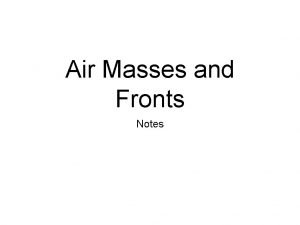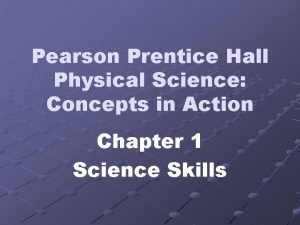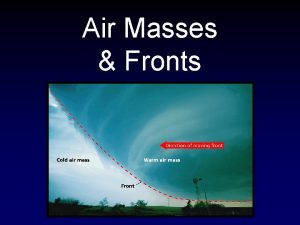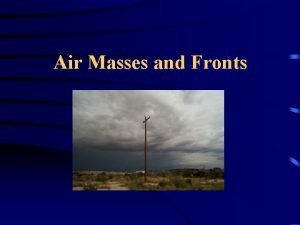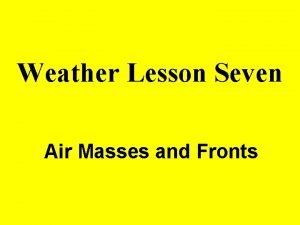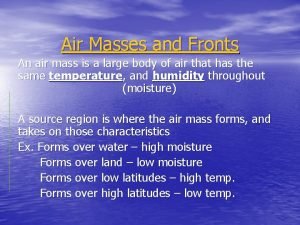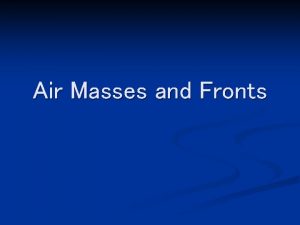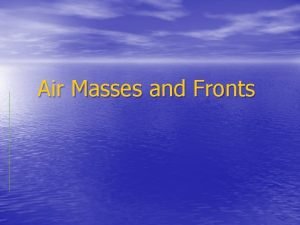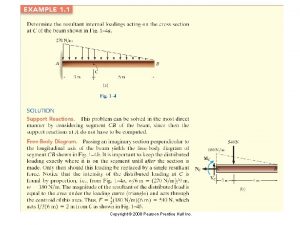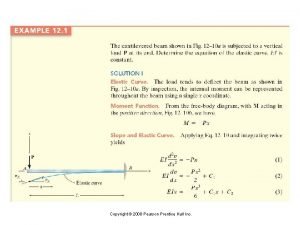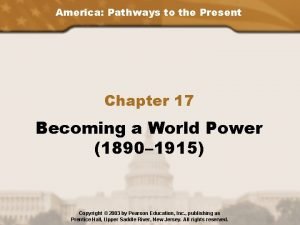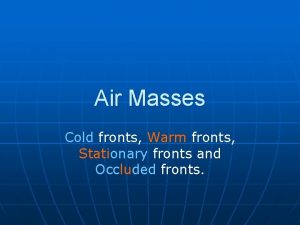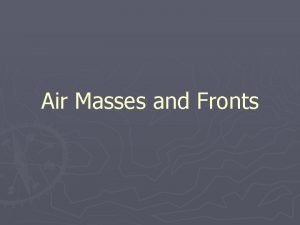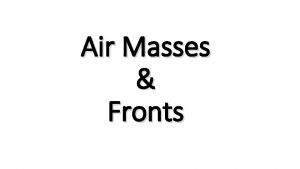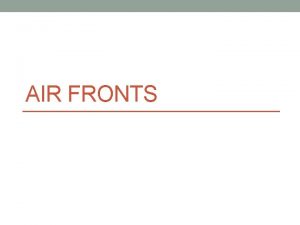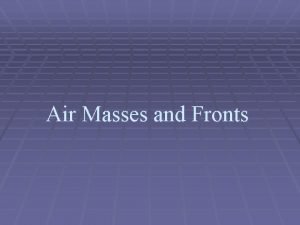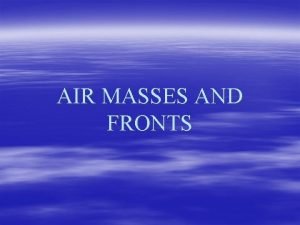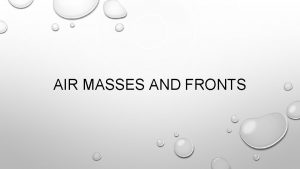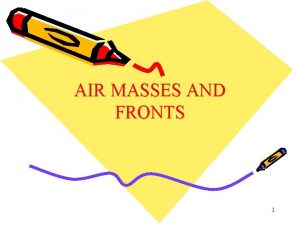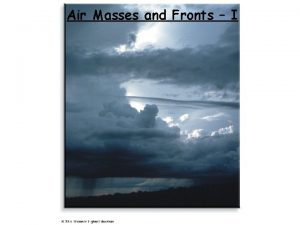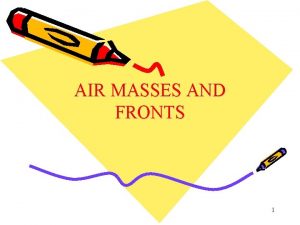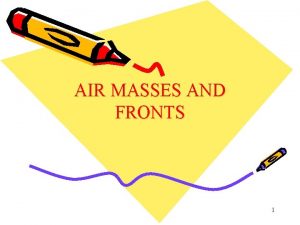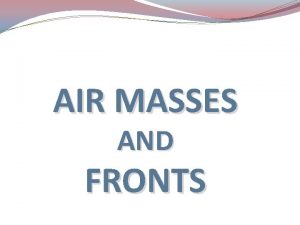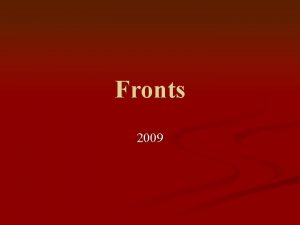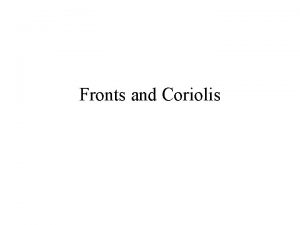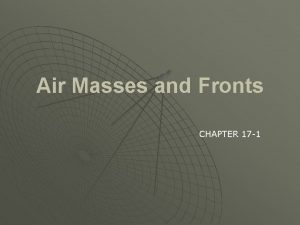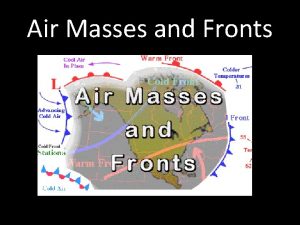Air Masses and Fronts 2006 Prentice Hall Science




















- Slides: 20

Air Masses and Fronts 2006 Prentice Hall Science Explorer-Earth Science

Air Mass § A huge body of air that has similar temperature, humidity, and air pressure at any given height is called an air mass. § There are four major types of air masses that influence the weather in North America: maritime tropical, continental tropical, maritime polar and continental polar.

§ The characteristics of an air mass depend on the temperatures and moisture content of the region over which the air mass forms. § Tropical, or warm, air masses form in the tropics and have low air pressure. § Polar, or cold, air masses form north of the 50 degrees north latitude and south of 50 degrees south latitude. Polar air masses have high air pressure.

§ Whether an air mass is humid or dry depends on whether it forms over water or land. § Maritime air masses form over oceans. Water evaporates from the oceans, so the air can become very humid. § Continental air masses form over land. Continental air masses have less exposure to large amounts of moisture from bodies of water. Therefore, continental air masses are drier than maritime air masses.

Maritime Tropical § Warm, humid air masses form over tropical oceans. Maritime tropical air masses that form over the Gulf of Mexico and the Atlantic Ocean move first into the southeastern United States. § In summertime, maritime tropical air masses usually bring hot humid weather. Many summer showers and thunderstorms in the eastern US develop in air masses that have formed over the Gulf of Mexico. § In winter, a humid air mass can bring heavy rain or snow.

Maritime Polar § Cool, humid air masses form over the icy cold North Pacific and North Atlantic oceans. § Maritime polar air masses affect the West Coast more than the East Coast. § These masses of cool, humid air often bring fog, rain and cool temperatures to the West Coast.

Continental Tropical § Hot, dry air masses form mostly in summer over dry areas of the Southwest and northern Mexico. § Continental tropical air masses cover a smaller area than other masses. § They occasionally move northeast, bringing hot, dry weather to the southern Great Plains.

Continental Polar § Large continental polar air masses form over central and northern Canada and Alaska. § Air masses that form near the Arctic Circle can bring bitterly cold weather with very low humidity. § In winter, continental polar air masses bring clear, cold, dry air to much of North America. In summer, the air mass is milder. Storms may occur when continental polar air masses move south and collide with maritime tropical air masses moving north.

How Air Masses Move § When an air mass moves into an area and interacts with other air masses, it causes the weather to change. § In the continental United States, air masses are commonly moved by the prevailing westerlies and jet streams.

Prevailing Westerlies § The prevailing westerlies, the major wind belts over the continental United States, generally push air masses from west to east.

Jet Streams § Jet streams are bands of high-speed winds about 10 km above Earth’s surface. § Embedded with the prevailing westerlies are jet streams. As jet streams blow from west to east, air masses are carried along their tracks.

Fronts § As huge masses of air move across the land the oceans, they collide with each other. But the air masses do not easily mix. § The boundary where the air masses meet becomes a front. Storms and changeable weather often develop along fronts.

Types of Fronts § Colliding air masses can form four types of fronts; cold fronts, warm fronts, stationary fronts, and occluded fronts.

Cold Fronts § Cold fronts tend to move quickly, they can cause abrupt weather changes, including thunderstorms. After a cold front passes through an area, colder, drier air moves in, often bringing clear skies, a shift in wind and lower temperatures.

Warm Fronts § In warm fronts, fast-moving warm air mass overtakes a slowly moving cold air mass. § If the warm air is humid, light rain or snow falls along the front. If the warm air is dry, scattered cloud form. § Because warm fronts move slowly, the weather may be rainy or cloudy for several days. After a warm front passes through an area, the weather is likely to be warm and humid.

Stationary Fronts § Sometimes cold and warm air masses meet, but neither one can move the other. The two air masses face each other in a “standoff”. § Where the warm and cool air meet, water vapor in the warm air condenses into rain, snow, fog, or clouds. If a stationary front remains stalled over an area, it may bring many days of clouds and precipitation.

Occluded Fronts § The most complex weather situation occurs at an occluded front, where a warm air mass is caught between two cooler air masses. § The warm air mass is cut off, or occluded, from the ground. As the warm air cools and its water vapor condenses, the weather may turn cloudy and rain or snow may fall.

Cyclones and Anticyclones § As air masses collide to form fronts, the boundary between the fronts sometimes becomes distorted by surface features such as mountains, strong winds or jet streams. § When this happens, a bend can develop and air begins to swirl. The swirling air can cause a low pressure to center to form.

Cyclones § If you look at a weather map, you will see areas marked with an L. The L stands for “low”, and indicates an area of relatively low air pressure. § A swirling center of low air pressure is called a cyclone, from Greek word meaning “wheel”. § Cyclones play a large part in the weather of the United States. As air rises in a cyclone, the air cools forming clouds and precipitation. Cyclones and decreasing air pressure associated with clouds, winds and precipitation.

Anticyclones § Anticyclones are the opposite of cyclones. Anticyclones are high-pressure centers of dry air. Anticyclones are usually called “highs” H on the weather map. § The descending air in an anticyclone generally causes dry, clear weather.
 What are middle-latitude cyclones?
What are middle-latitude cyclones? How a warm front forms
How a warm front forms North american air masses
North american air masses North american air masses
North american air masses Pearson physical science concepts in action
Pearson physical science concepts in action Two cold air masses converge on a warm air mass
Two cold air masses converge on a warm air mass Air masses & frontswhat is an air mass?
Air masses & frontswhat is an air mass? Air masses & frontswhat is an air mass?
Air masses & frontswhat is an air mass? The boundary between two adjacent air masses is called
The boundary between two adjacent air masses is called A swirling center of low air pressure is called
A swirling center of low air pressure is called Air masses & frontswhat is an air mass?
Air masses & frontswhat is an air mass? Air masses & frontswhat is an air mass?
Air masses & frontswhat is an air mass? Stationary front
Stationary front Copyright 2008
Copyright 2008 Prentice hall inc
Prentice hall inc 2008 pearson prentice hall inc
2008 pearson prentice hall inc 2005 pearson prentice hall inc
2005 pearson prentice hall inc Pearson prentice hall
Pearson prentice hall Prentice hall inc
Prentice hall inc Prentice hall careers
Prentice hall careers Prentice hall america pathways to the present
Prentice hall america pathways to the present

